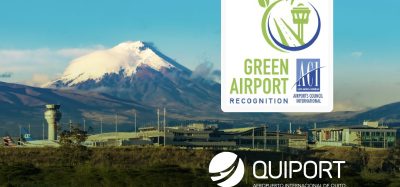Avian radar systems
Posted: 30 November 2007 | Edwin E. Herricks, Center of Excellence in Airport Technology and Gerry Key, Computer Sciences Corporation | No comments yet
Mayday, Mayday, Mayday, Thompson 253! – Thus begins the audio following a slow motion video of a bird/aircraft collision. The mayday is called as flames shoot from the left engine of a Thompson Boeing 757. This bird strike on takeoff rivets our attention for over 6 minutes as the professionalism of pilots and controllers is documented in a safe, one engine landing. YouTube has again provided us with access to a video record and graphic evidence for the need to prevent bird/aircraft collisions.
Mayday, Mayday, Mayday, Thompson 253! – Thus begins the audio following a slow motion video of a bird/aircraft collision. The mayday is called as flames shoot from the left engine of a Thompson Boeing 757. This bird strike on takeoff rivets our attention for over 6 minutes as the professionalism of pilots and controllers is documented in a safe, one engine landing. YouTube has again provided us with access to a video record and graphic evidence for the need to prevent bird/aircraft collisions.
The Thompson 757 strike is added to recent incidents of bird/aircraft collisions with large two engine aircraft at Chicago’s O’Hare International Airport and Rome’s Fiumicino Airport. Although the bird strike problem has been with aircraft since the days of the Wright brothers, there is new urgency as increasing numbers of large birds that fly in flocks are on a collision course with a commercial fleet, dominated by two engine aircraft. The risk of catastrophe looms larger and larger!
The question is what to do? We might begin to answer that question by summarising what we do know. Because of steep take-off and approach paths, birds present the greatest hazard on runways and in the airspace above the airport. Low flying birds are progressively less hazardous as we move away from the airport, although migratory birds, flying at altitude can be a significant hazard at higher altitudes. A review of bird strike statistics finds that 90+% of aircraft collisions with birds occur below 3000 ft AGL. This recognition of low altitude bird strike hazards has resulted in a focus on wildlife management at airports with the greatest attention paid to areas near runways. Bird harassment techniques and harassment technologies have become very sophisticated, but airport supported management usually stops at the fence. The bird problem is not limited to airport property. The bird problem has local, regional, even continental components.
Free webinar – The future of asset management in global aviation
15 January, 2026, 02:00PM GMT
Join this virtual panel to hear from some of the AtkinsRéalis and aviation sector experts as we discuss how asset management is changing and the impact it will have on the future operations of airports throughout the world.
There is a clear need for wildlife management to extend its reach beyond the fence. New tools are needed! Tools that afford a regional, as well as a local, contribution to the reduction of bird strike hazards. These tools must scan the sky from near the ground to altitudes of 3000 ft or more above the airport. They must provide continuous, near real-time identification of hazards, so that air traffic managers can address the local problem of knowing when birds are present in an approach or departure corridor and wildlife managers can consider regional bird movement and solutions. Clearly there is a need to gather data on where and when birds are present, both on and beyond the airport property and on activity patterns that can change from time of day, throughout the year, or among years. Armed with this information, wildlife managers can address the broader issue of understanding (and perhaps modifying) factors that are attracting different species of birds to the airport environment, considering both local and regional solutions.
A key technology is radar. Radars have been used to study birds since the 1940s, shortly after the first radar units were developed. Since then a wide range of radar systems have been used in ornithology and bird strike hazard prevention. An obvious place to start would be the use of existing radar systems for bird hazard management. NEXRAD weather radars are in place and are being used by ornithologists as research tools to identify and track bird movement at distances of 60 nmi and beyond. Products from NEXRAD radars are used to create hazard advisories over a national scale. Airport Surveillance Radars (ASR) are very effective at detecting birds over a range of 6 to 60 nmi; unfortunately, birds are generally classified with other clutter and removed from the images so that the operators can focus on aircraft movement.
These large, complex and costly radar systems do have the potential to provide regional data on bird movements and altitudes above 3000 ft, but they do not cover areas close to the airport runway. A radar that works well over short ranges (0-6 nmi) and low altitudes (0-3000 ft AGL), the zone of highest hazard around airports, is needed. Although an avian radar should focus on the immediate vicinity of the airport, a comprehensive bird hazard management system should integrate existing radars with avian radar systems to provide both regional and local coverage. That integration is not the topic of this paper, rather the topic is local avian radars that support both hazard assessment and warnings and local wildlife management.
Recently, a new class of dedicated avian radars has been developed to address local surveillance needs. Most of these systems employ low cost, off the shelf X-band marine radars that were originally designed to detect large, highly reflective targets like boats and shorelines located on reasonably predictable and flat surfaces. These radars were not designed to detect small, feathery, and highly maneuverable biological targets moving freely in three dimensions. Moreover, these marine radars have an analogue output so the most common application finds humans observing the radar screen to determine target detection and movement. While a few studies have documented detection with corresponding bird observations, the targets the operator sees on the screen may be birds, bats, insects or non-biological targets such as vehicles moving along roads, rails, or farm fields.
The recent introduction of high-speed and affordable digital signal processing technology has made it possible to digitise the analogue signal from these inexpensive marine radars. Once digitised, the radar returns can be processed automatically in real-time using sophisticated algorithms to remove clutter, detect potential targets and track those targets using easily understandable displays. Preliminary results from the use of avian radars is promising. Nonetheless, the air and ground personnel upon whom the safety of the aircraft, crew, and passengers ultimately depend must have confidence in radar detections. This confidence will not come from vendor marketing literature, but rather from data that has been developed in carefully designed studies and published in the open literature. Acceptance will first find the approval of the scientific and technical community and then acceptance by the user community in their day to day activities. Toward those ends, the FAA and Navy are now undertaking detailed performance assessments and validation studies of avian radar systems with the cooperation of both civilian and military users.
In 2006, the FAA developed a programme to assess the performance of commercially available avian radars in airport settings. This effort is intended to develop sufficient technical and operational information on bird radar sensors and associated technical and data systems to develop requirements and standards for bird radar deployment at airports. The radar systems selected for trials must meet objectives on three levels: 1) providing the support for the broader FAA airport and aircraft safety programme; 2) meeting the need for technology evaluation and scientific validation; and 3) addressing the needs of local wildlife management at airports. Although these objectives could be competing, the avian radar assessment efforts have integrated all objectives to design a performance assessment that is comprehensive and functional.
In 2006 the U. S. Navy’s SPAWAR Systems Center in San Diego, CA formed a team of investigators from government (including the FAA), industry and academia, to validate avian radar technologies under real-world operational conditions, at multiple sites, streaming the data across a network for remote processing and fusion with data from multiple radar sensors. Because the avian radars are a new technology, whose capabilities had not been validated with studies available to the public and because there is a need to evaluate avian radar systems that employ state-of-the-art automated detection and tracking algorithms, the Integration and Validation of Avian Radars (IVAR) project was initiated as part of the Department of Defence’s Environmental Security Technology Certification Program (ESTCP) in 2006.
The FAA and the Navy have joined forces in a cooperative effort, connecting IVAR with the FAA’s performance assessments. The FAA programme intends to develop a national data management system for radar and wildlife management, but initial cooperative efforts have found a connection solution in the Sicom Systems, Ltd. Accipiter® Digital Radar Processor (DRP)/Digital Radar Server (DRS) product. With a focus on validation and improvement of radar’s contribution to wildlife management, the IVAR programme is filling the need for scientific assessment of radar ornithology applications. This allows FAA performance assessments to concentrate on airport applications of radar technology. The use of the DRP/DRS, with modern radar sensors, allows the use of different radar units and different radar configurations at distant locations, with integrated products supporting radar data analysis and interpretation.
The general findings of the performance assessment to date indicate that avian radars will have a role to play in improving airport safety and they will assist in the expansion of wildlife management capabilities for hazard management. Unfortunately, radar is a complex technology and the limits of physics come into play when matching expectations with performance. Radars depend on signal generation and echo reception to initiate the detection process. The type and configuration of the antenna, power, wavelength, and a number of other factors will determine how effective a radar can operate in a local setting and under variable weather conditions. A major consideration is the antenna. Some antennas provide good horizontal tracking performance, but no good altitude discrimination. It is possible to more accurately determine altitude, but this will require an antenna configuration that will not present as good a view of the general setting. Thus hardware selection is an initial first step, which will be directed by observational needs rather than technical possibility. Bird targets are notoriously difficult to work with. Birds present different aspects of their bodies to the radar signal as they fly, so detection can change over short time spans. Further, verification of the species detected or translation of echo characteristics into the size or weight of a detected bird has not been validated. What the radar can do very well is track a target. What is needed is validation that the target is a bird, or a likely hazard to aircraft safety. Next, radars generate tremendous quantities of data. A reasonable analogy is trying to drink from a fire hose, because data is generated with each sweep of the antenna and operations are 24/7. There is a clear need for several levels of data post-processing and each of these levels of data processing must be assessed and validated. Finally, there is the question of what to do with all of the data. How do we take complex data sets and present a useful product to pilots, controllers and local wildlife managers?
The FAA performance assessment project is addressing these issues with the cooperation of the military, airports and academics. The performance assessment programme will operate avian radars at airports and the first installation is operating at Seattle-Tacoma International Airport (SEA). A second radar has also been operational at the Naval Air Station, Whidbey Island. Other radar systems are planned for John F. Kennedy International Airport (JFK), Dallas-Fort Worth International Airport (DFW), and O’Hare International Airport (ORD). As a cooperative effort, to date the IVAR project has conducted detection validation studies at airfields in North Carolina, Maryland and California. The FAA performance assessment programme is intended to meet general objectives for airspace safety, while addressing objectives focused on local hazard assessment and wildlife management, using radars that have been carefully sited with hardware selected to meet local requirements. The IVAR project is in the early stages of a three-year effort to demonstrate and validate the operation of avian radars in wildlife management and in the specific needs of military aviation.
In summary, avian radar is a new tool, possibly a whole new toolbox that will contribute significantly to improved airport and air space safety. Radars expand the reach of observation to ranges important to wildlife, provide detailed tracking of targets and operate 24/7, adding night-time observations to the management picture. Avian radar systems are not a mature technology, the promise is much greater than proven applications, but ongoing performance assessments and validation studies are confirming promise, suggesting a bright future for this technology at airports.
Stay Connected with International Airport Review — Subscribe for Free!
Get exclusive access to the latest airport and aviation industry insights from International Airport Review — tailored to your interests.
✅ Expert-Led Webinars – Gain insights from global aviation leaders
✅ Weekly News & Reports – Airport innovation, thought leadership, and industry trends
✅ Exclusive Industry Insights – Discover cutting-edge technologies shaping the future of air travel
✅ International Airport Summit – Join our flagship event to network with industry leaders and explore the latest advancements
Choose the updates that matter most to you.
Sign up now to stay informed, inspired, and connected — all for free!
Thank you for being part of our aviation community. Let’s keep shaping the future of airports together!
















